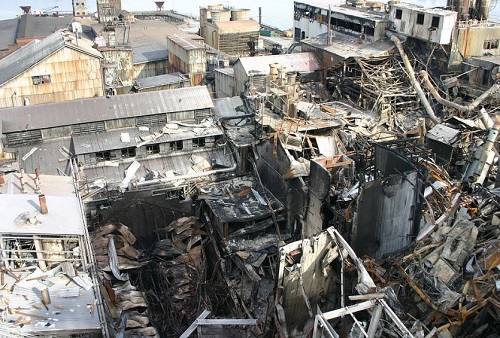Combustible Dust Particles: How to Reduce Risk
Fact: most types of material are capable of forming combustible dust. This includes both natural and synthetic materials. Flour, starch, feed, wood, textiles, dyes, coals, metals, plastics, and many more substances can pose a combustion hazard. There are many potential ignition sources, such as a welding arc or electrical arc, an electrical short, a spark from a piece of equipment, friction, or any open flame. Sources like static, hot machine surfaces, or overheated equipment, and cigarettes are less likely to cause ignition but are still considered to be risk factors.
While you probably don’t have a choice in which materials are used in your processes, there are steps that can be taken to minimize the risk of fire and explosion.

Aftermath of 2008 explosion at Imperial Sugar in Port Wentworth, Georgia
Wear protective clothing.
Anyone working in an area where combustible dust particles may accumulate should always wear flame resistant garments. In a flash fire, flammable clothing can turn a minor mishap into a major tragedy.
Employ good housekeeping practices.
Cleaning up properly is something that can easily be overlooked in the face of the other demands of material processing. However, it is a key part of minimizing the risks associated with combustible dust particles. Keep horizontal surfaces to a minimum to cut down on dust accumulation, and promptly clean up the dust that does settle.
Pay attention to your shop setup.
Make sure your shop is designed to keep the risk of combustion at a minimum. This means using all means of explosion protection and dust collection equipment necessary for your operation. Use only equipment designed to minimize dust. Your electrical equipment should be in good working order and undergo regular inspections.
Take care with ventilation.
Maintaining a good ventilation system is a key component of running a safe shop. Always make sure ventilation is adequate in work areas. All explosion vents and dust collectors must be directed toward a safe outdoor location. Take care to make sure they do not redirect back into any work area. Ductwork must be bonded, grounded and made of metal.
Know your materials.
Part of practicing combustible dust safety is understanding the materials you’re working with. Know the minimum ignition energy, minimum ignition temperature, and minimum explosible concentration for any combustible dust you work with. In some cases, it doesn’t take much for an explosion to happen, as some materials require very little dust to be present to become potentially flammable.
Get your emergency response plan together.
The best cure is prevention, but you need to have a clear plan and adequate resources to handle a worst-case scenario. Go over emergency response protocols with all staff and regularly check placement and readiness of emergency response materials, such as fire extinguishers. Create a clear evacuation protocol and review it as necessary.
The risks associated with combustible materials need to be discussed and understood so that the right steps can be taken to keep those risks at a minimum. By keeping up with the little things, like proper maintenance and mindful shop construction, you can run a safe operation when working with potentially combustible materials.
